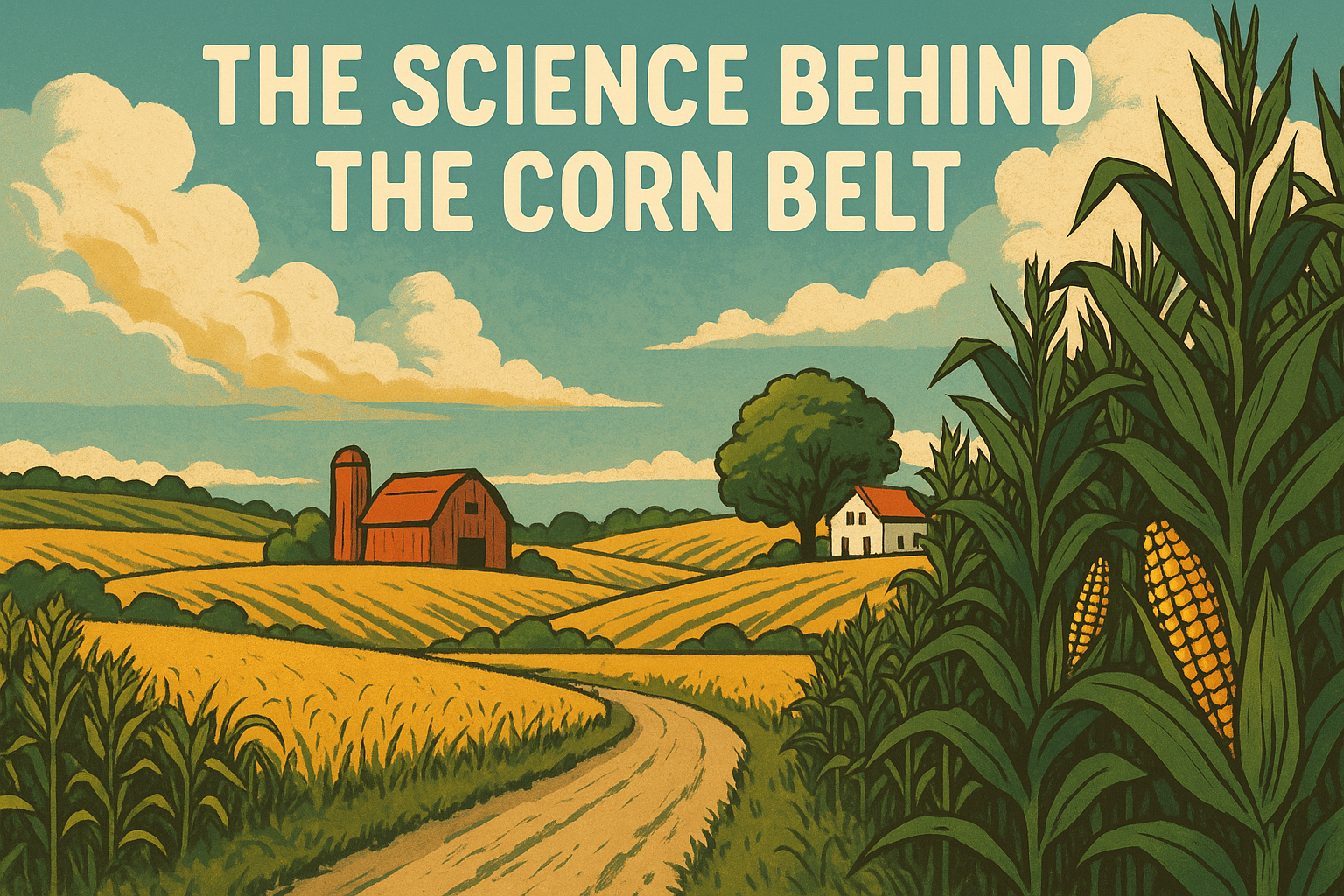🌽 “It’s More Humid in Iowa Than Florida”: The Science Behind the Corn Belt Exploring how corn makes

Exploring how corn makes the Midwest wetter—and what it means for the planet
“Would you believe if a farmer from Iowa told you it was more humid in the Midwest than Florida?”
At first glance, it sounds like a tall tale. How could landlocked Iowa—with no ocean breeze or tropical storms—feel stickier than a beach town in Florida?
But believe it or not, this claim holds water—literally. Every summer, millions of acres of corn stretch across the American Midwest, creating a zone that is not only agriculturally powerful but also climatologically unique. This region is known as the Corn Belt, and it's not just feeding America—it's changing the weather.
In today’s newsletter, we dig into what the Corn Belt is, how it became one of the most productive agricultural zones on Earth, and what unexpected consequences its scale and success have had on the environment.

🌽 What Is the Corn Belt?
The Corn Belt refers to a region of the United States where corn is the dominant crop, both economically and ecologically. While the boundaries vary slightly, it typically includes:
- Iowa
- Illinois
- Indiana
- Ohio
- Minnesota
- Missouri
- Parts of Nebraska, Kansas, and South Dakota
This area exploded in productivity in the mid-20th century due to mechanized farming, synthetic fertilizers, genetically modified seeds, and government subsidies.
Today, the U.S. produces over 15 billion bushels of corn annually, much of it from this belt. Corn from this region fuels not just food systems, but also ethanol production, animal feed, and processed goods around the world.
💧 Why Is It So Humid?
The phenomenon of "corn sweat" is real. It’s not just a clever nickname—it's a measurable process called evapotranspiration.
Here's how it works:
- Corn plants pull water from the soil and release it through tiny pores in their leaves.
- This water vapor enters the atmosphere, increasing local humidity.
- When millions of acres do this at once, the humidity can spike dramatically—even more than in some coastal states.
In fact, a single acre of corn can release up to 4,000 gallons of water into the air per day during peak growing season. Multiply that across the Corn Belt, and you've got a significant contributor to regional moisture.
🌎 Environmental Impacts of the Corn Belt
While incredibly productive, the Corn Belt’s vast monoculture farming has ecological costs:
🌾 1. Soil Erosion & Nutrient Depletion
Growing corn year after year in the same soil strips it of vital nutrients, requiring heavy fertilizer use. This degrades soil health and increases reliance on synthetic inputs.
💧 2. Water Pollution
Excess nitrogen from fertilizers runs off into rivers and eventually into the Mississippi River, contributing to the Gulf of Mexico’s “dead zone”—a large area of hypoxic (low-oxygen) water that can't support marine life.
☁️ 3. Climate Alteration
Beyond just humidity, evapotranspiration also affects:
- Cloud formation
- Rainfall patterns
- Regional cooling
Interestingly, some studies suggest the Corn Belt cools the region by up to 1°C due to the latent heat of all that evaporating water—essentially functioning as a regional air conditioner.
🐝 4. Biodiversity Loss
Monocultures leave little room for native plants and animals. The rise of corn and soybean fields has replaced prairies, wetlands, and forests once rich in biodiversity.
🌱 Why This Matters
The Midwest Corn Belt is a prime example of how human activity shapes the natural world at scale. This vast green engine feeds nations and fuels vehicles, but also rewrites weather systems and alters ecosystems. Understanding the science behind this phenomenon helps us appreciate the trade-offs between agricultural productivity and environmental health.
With climate change looming, the Corn Belt might also become a canary in the cornfield, showing us how ecosystems adapt—or struggle—to human-driven transformations.

🔭 Spotlight on Future Applications
- Sustainable Ag Practices: Regenerative farming, cover cropping, and crop rotation can help preserve soil and reduce runoff.
- Climate Modeling: Scientists now factor in crop-induced humidity and land use when modeling Midwestern weather and drought predictions.
- Alternative Crops: Researchers are exploring drought-resistant, nutrient-efficient crops to diversify the Corn Belt.
🌽 Did You Know?
- Corn is not just food—it’s found in tires, makeup, batteries, adhesives, and plastics.
- The Corn Belt is so large, it can be seen from space when corn reaches peak growth in July.
- Iowa alone produces more corn than Mexico and Canada combined.
💭 Reflection Questions
- What balance should we strike between food production and environmental sustainability in agriculture?
- How might climate change shift the Corn Belt northward—or shrink it entirely?
- Could future crops offer the same productivity without the environmental cost?
📚 References
- U.S. Department of Agriculture (USDA). (2024). Crop Production Annual Summary
- National Geographic. (2020). The Corn Belt’s Impact on Climate
- NOAA. (2023). Dead Zone Forecasts in the Gulf of Mexico
- Nature Communications. (2018). “Evapotranspiration in the Midwest Corn Belt alters regional climate.”
- Environmental Working Group. (2021). Fertilizer Runoff and Water Quality
